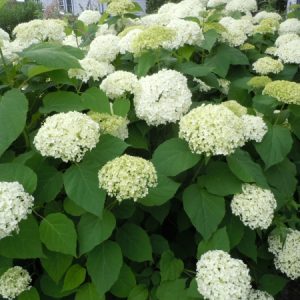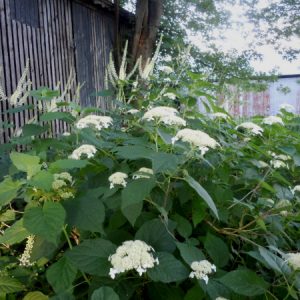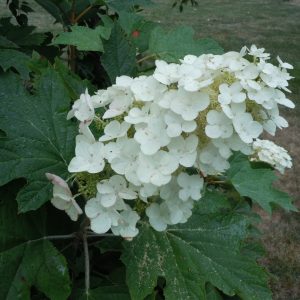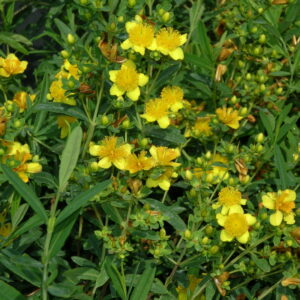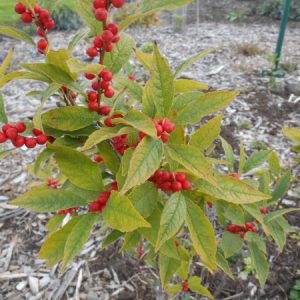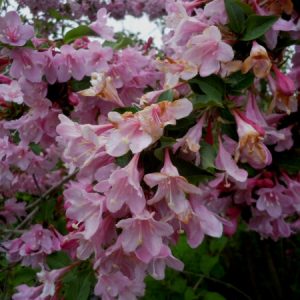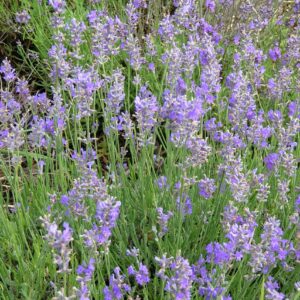Woody Ornamentals
Showing 25–32 of 46 results
-
Hydrangea arborescens ‘Annabelle’, Annabelle hydrangea, Snowball hydrangea Z 4-9
Flowering from late June to October, softball sized or bigger ivory heads fade to pale green. Toughest, easiest hydrangea to grow.
Flowering from late June to October, softball sized or bigger ivory heads fade to pale green. Toughest, easiest hydrangea to grow.
Size: 3-5’ x 3-5’
Care: Shade to sun in clay to well-drained soil. Prune back in early spring to 12-16” above the soil level.
Native: Southeastern US
Awards: Received England’s Royal Horticultural Society Award of Merit & Pennsylvania Horticultural Society Gold Medal Plant Award.Hydrangea is Greek from hydor meaning water and aggeion meaning vessel referring to the cup shaped fruit. The dried root was used as medicine – as a cathartic and diuretic. ‘Annabelle,’ the showy form, first collected around 1900 near Anna Illinois. The story of the ‘Annabelle’ hydrangea begins in southern Illinois near the town of Anna. In 1910, Harriet Kirkpatrick, went on a horseback ride along a wooded trail in Union County and noticed a beautiful native hydrangea with abnormally large, snowball-like blooms. Together with her sister-in-law, Amy Kirkpatrick, she went back to dig up the native shrub and transplant it into her yard in Anna. Neighbors and friends noticed the showy plant and the Kirkpatrick family shared specimens of the easily transplantable shrub, spreading its progeny throughout Anna and other towns in Illinois.
Given its wide local popularity, easy transplanting and culture, Mrs. Kirkpatrick contacted the Burpee Seed Company to see if there was interest in developing the new variety commercially. Unbeknownst to the Kirkpatrick’s, a recent improved cultivar of Hydrangea arborescens had been released in 1906. E. G. Hill brought the ‘Snowhill’ hydrangea into production from a wild specimen found near Yellow Springs, Ohio with similar abnormally large, snowball-like flowers, but an earlier bloom time.
So, for the next 50 years, ‘Annabelle would be an unnamed, but locally poplar cultivar, that was distributed by word of mouth throughout southern Illinois, finally reaching Urbana around 1935, based on the first recorded account.
It wasn’t until the 1960’s that the Kirkpatrick’s find gained the attention of University of Illinois professor and renowned plantsman, Dr. Joseph C. McDaniel. In 1960, McDaniel rediscovered ‘Annabelle’ by noticing it in cultivation in Urbana, IL. He traced it back to Anna, IL, collected samples for propagation, named the cultivar and released it for commercial production in 1962.
**LISTED AS OUT OF STOCK BECAUSE WE DO NOT SHIP THIS ITEM. IT IS AVAILABLE FOR PURCHASE AT OUR RETAIL LOCATION.
-
Hydrangea arborescens Z 4-9
Small white fertile flowers bloom in May-July in flattened clusters (corymbs to 2-6” across). Scattered continuing flowering may occur through September. Large sterile flowers usually appear in the cluster for a lacecap. Flowers give way to dehiscent seed capsules which ripen in October-November.
Small white fertile flowers bloom in May-July in flattened clusters (corymbs to 2-6” across). Scattered continuing flowering may occur through September. Large sterile flowers usually appear in the cluster for a lacecap. Flowers give way to dehiscent seed capsules which ripen in October-November.
Size: 3-5’ x 3-5’
Care: Shade to sun in moist well-drained to well-drained soil. Prune back in early spring to a foot above soil level.
Native: Southeastern U.S.
Wildlife Value: provides nectar and pollen to bees and butterflies and seeds to birds
Awards: Missouri Botanic Garden Plant of Merit.Hydrangea is Greek from hydor meaning water and aggeion meaning vessel referring to the cup shaped fruit. John Clayton (1694-1773) found this in the 1730’s in Virginian. This flowered in England for Peter Collinson (1694-1768) international merchant and active plant promoter, in 1746. Grown at America’s 1st botanic garden, Elgin Botanic Garden 1811.
**LISTED AS OUT OF STOCK BECAUSE WE DO NOT SHIP THIS ITEM. IT IS AVAILABLE FOR PURCHASE AT OUR RETAIL LOCATION.
-
Hydrangea quercifolia Oakleaf hydrangea Z 5-9
Large blossoms, white turning pink and dark rose as the season advances. In fall the oak-shaped leaves become burgundy.
Large blossoms, white turning pink and dark rose as the season advances. In fall the oak-shaped leaves become burgundy.
Size: 4-5’ x 10’ slowly spreading by suckers.
Care: sun to part shade in moist well-drained soil. Protect the 1st few winters from rabbits eating young branches. It blooms on branches that overwintered so rabbit-eating or pruning after spring will prevent flowering.
Native: SE US
Wildlife Value: provides nectar and pollen to bees and butterflies and seeds to birdsCollected in central Georgia by William Bartram (1739-1823) c. 1775. Bartram, “most significant American nature writer before Thoreau,” traveled the wilderness of the SE, then colonies, now US, mostly alone, sometimes with his famous father, John Bartram. William wrote about and illustrated the flora, native Americans, animals, and insects. Grown at America’s 1st botanic garden, Elgin Botanic Garden 1811.
**LISTED AS OUT OF STOCK BECAUSE WE DO NOT SHIP THIS ITEM. IT IS AVAILABLE FOR PURCHASE AT OUR RETAIL LOCATION.
-
Hypericum kalmianum Kalm’s St. Johns wort SHRUB Z 4-7
Eye-catching yellow saucers with a puff of showy prominent stamens in mid to late summer complimenting the glaucous blue leaves on this mounding, easy- to-grow, shrub.
Eye-catching yellow saucers with a puff of showy prominent stamens in mid to late summer complimenting the glaucous blue leaves on this mounding, easy- to-grow, shrub.
Size: 3-4’ x 3-4’
Care: sun to shade in well-drained to moist well-drained soil. Blooms on new growth so prune in late winter to early spring as far back as you wish.
Native: Quebec to WI, S. to IL, Wisconsin native.
Wildlife Value: attracts bees and butterflies
Awards: Great Plants for Great PlainsThe name Hypericum comes from Greek hyper, meaning above, and eikon, meaning icon or image. The yellow flowers of some species were placed above images to ward off evil spirits, and according to legend, Satan pierced the leaves in revenge. This species collected by and named for Peter Kalm (1716-1779), Swedish plant hunter, on his expedition in North America, 1747-1751. Offered for sale in Bartram Garden’s 1783 Broadside, America’s 1st plant catalog. David Douglas (Douglas fir guy) also collected this at Niagara Falls per British botanist William Jackson Hooker (1785-1865).
**LISTED AS OUT OF STOCK BECAUSE WE DO NOT SHIP THIS ITEM. IT IS AVAILABLE FOR PURCHASE AT OUR RETAIL LOCATION.
-
Ilex verticillata Winterberry holly Z 3-9 FEMALE
White flowers in May turning to dense clusters of lurid red berries lasting from fall into winter on female plants. One male needed to fertilize 3 or 4 4 female plants. Female plants have a plump round ovary at the center and vestigial stamens – sticks up; male flowers have a greatly reduced and lower center-and prominent stamens with ample pollen.
White flowers in May turning to dense clusters of lurid red berries lasting from fall into winter on female plants. One male needed to fertilize 3 or 4 4 female plants. Female plants have a plump round ovary at the center and vestigial stamens – sticks up; male flowers have a greatly reduced and lower center-and prominent stamens with ample pollen.
Size: 6-16’ x 6-10’
Care: sun to part shade in moist to moist well-drained, acidic soil
Native: Canada to FL, West to WI and MO. Wisconsin native
Wildlife Value: Berries are important winter food for Robin, Bluejay, Catbird, Cedar waxwing, Chickadee, Finch, Flicker, Mockingbird, Mourning dove, Nuthatch, Sparrow, Tanager, Thrasher, Towhee, Warbler, Woodpecker.Natives Americans used bark to induce vomiting, to remedy craziness and a decoction of roots to cure hay fever. Ojibwa used roots as remedy for diarrhea. Collected before 1753 by John Bartram (1699-1776) who called it “Prinos.” Jefferson described the Winterberry in Virginia, “the swamps in this neighborhood are now red with this berry… (it is) peculiar to America and is a real treasure.” Grown at America’s 1st botanic garden, Elgin Botanic Garden 1811. L H Bailey (1933) called it, “one of the best hardy shrubs with ornamental fruits.”
Require a male and female plant for cross pollination. This is the female plant that will produce the berries. Generally, only 1 male shrub should be needed to pollinate 3-4 female shrubs.
**LISTED AS OUT OF STOCK BECAUSE WE DO NOT SHIP THIS ITEM. IT IS AVAILABLE FOR PURCHASE AT OUR RETAIL LOCATION.
-
Ilex verticillata Winterberry holly Z 3-9 MALE
White flowers in May turning to dense clusters of lurid red berries lasting from fall into winter on female plants. One male needed to fertilize 3 or 4 4 female plants. Female plants have a plump round ovary at the center and vestigial stamens – sticks up; male flowers have a greatly reduced and lower center-and prominent stamens with ample pollen.
White flowers in May turning to dense clusters of lurid red berries lasting from fall into winter on female plants. One male needed to fertilize 3 or 4 4 female plants. Female plants have a plump round ovary at the center and vestigial stamens – sticks up; male flowers have a greatly reduced and lower center-and prominent stamens with ample pollen.
Size: 6-16’ x 6-10’
Care: sun to part shade in moist to moist well-drained, acidic soil
Native: Canada to FL, West to Wisconsin and MO.
Wildlife Value: Berries are important winter food for Robin, Bluejay, Catbird, Cedar waxwing, Chickadee, Finch, Flicker, Mockingbird, Mourning dove, Nuthatch, Sparrow, Tanager, Thrasher, Towhee, Warbler, Woodpecker.Natives Americans used bark to induce vomiting, to remedy craziness and a decoction of roots to cure hay fever. Ojibwa used roots as remedy for diarrhea. Collected before 1753 by John Bartram (1699-1776) who called it “Prinos.” Jefferson described the Winterberry in Virginia, “the swamps in this neighborhood are now red with this berry… (it is) peculiar to America and is a real treasure.” Grown at America’s 1st botanic garden, Elgin Botanic Garden 1811. L H Bailey (1933) called it, “one of the best hardy shrubs with ornamental fruits.”
Require a male and female plant for cross pollination. This is the female plant that will produce the berries. Generally, only 1 male shrub should be needed to pollinate 3-4 female shrubs
**LISTED AS OUT OF STOCK BECAUSE WE DO NOT SHIP THIS ITEM. IT IS AVAILABLE FOR PURCHASE AT OUR RETAIL LOCATION.
-
Kolkwitzia amabilis syn Linnaea amabilis Beautybush Z. 5-9 SHRUB
Profuse pale to dark pink bell flowers with yellow throats grace this arching shrub in early summer
Profuse pale to dark pink bell flowers with yellow throats grace this arching shrub in early summer
Size: 10’ x 12’
Care: Full sun in well-drained soil. Flowers on last season’s wood so prune just after blooms fade.
Native: China
Wildlife Value: attracts butterflies, and beesNamed for Richard Kolkwitz, (1873-19560 botany professor in Berlin. First introduced to the West by Ernest Henry “Chinese” Wilson who found it in the mountains near Ichang and sent its seeds to the Veitch Nursery in England in 1901. Harvard’s Arnold Arboretum received the shrub in 1907. It was one of Wilson’s favorite plants out of his hundreds of finds. Wilson wrote, “(a)mong the deciduous-leaved shrubs that central and western China has given to American gardens Kolkwitzia stands in the front rank.” Arnoldia 68/2.
**LISTED AS OUT OF STOCK BECAUSE WE DO NOT SHIP THIS ITEM. IT IS AVAILABLE FOR PURCHASE AT OUR RETAIL LOCATION.
-
Lavandula angustifolia ‘Munstead’ Z 5-9
Very fragrant, compact form of Lavender blooms in wands July-September.
Very fragrant, compact form of Lavender blooms in wands July-September.
Size: 12-18” x 12-18”
Care: Sun, well-drained, soil. Prune to 8” in spring every 2 years to control plant size and promote new growth.
Native: species native to Western Mediterranean
Wildlife Value: Attracts many different bee species and butterflies. Resistant to rabbits and deerThis selection introduced to gardens in 1916. Named for Munstead Woods in England, the home of the extraordinary garden designer Gertrude Jekyll (1843-1932) Lavandula is Latin from lavare meaning “to wash” because it was thrown into baths for the scent, “or because used in lye to give a fragrancy to linen; and because it is very good to wash the face with, and give it both beauty and a grateful scent.”

